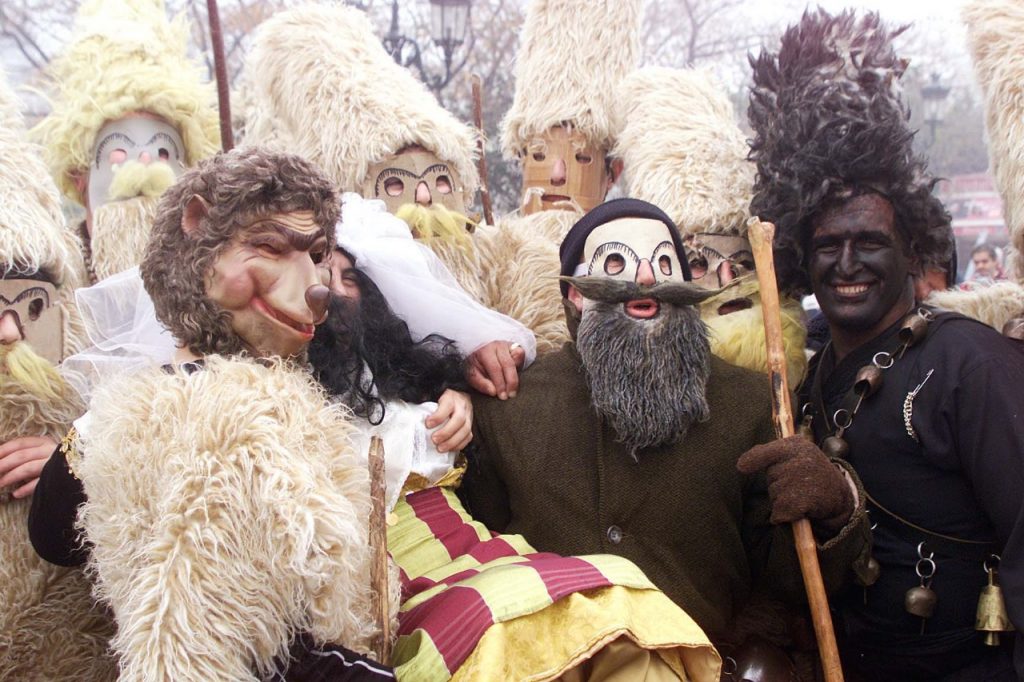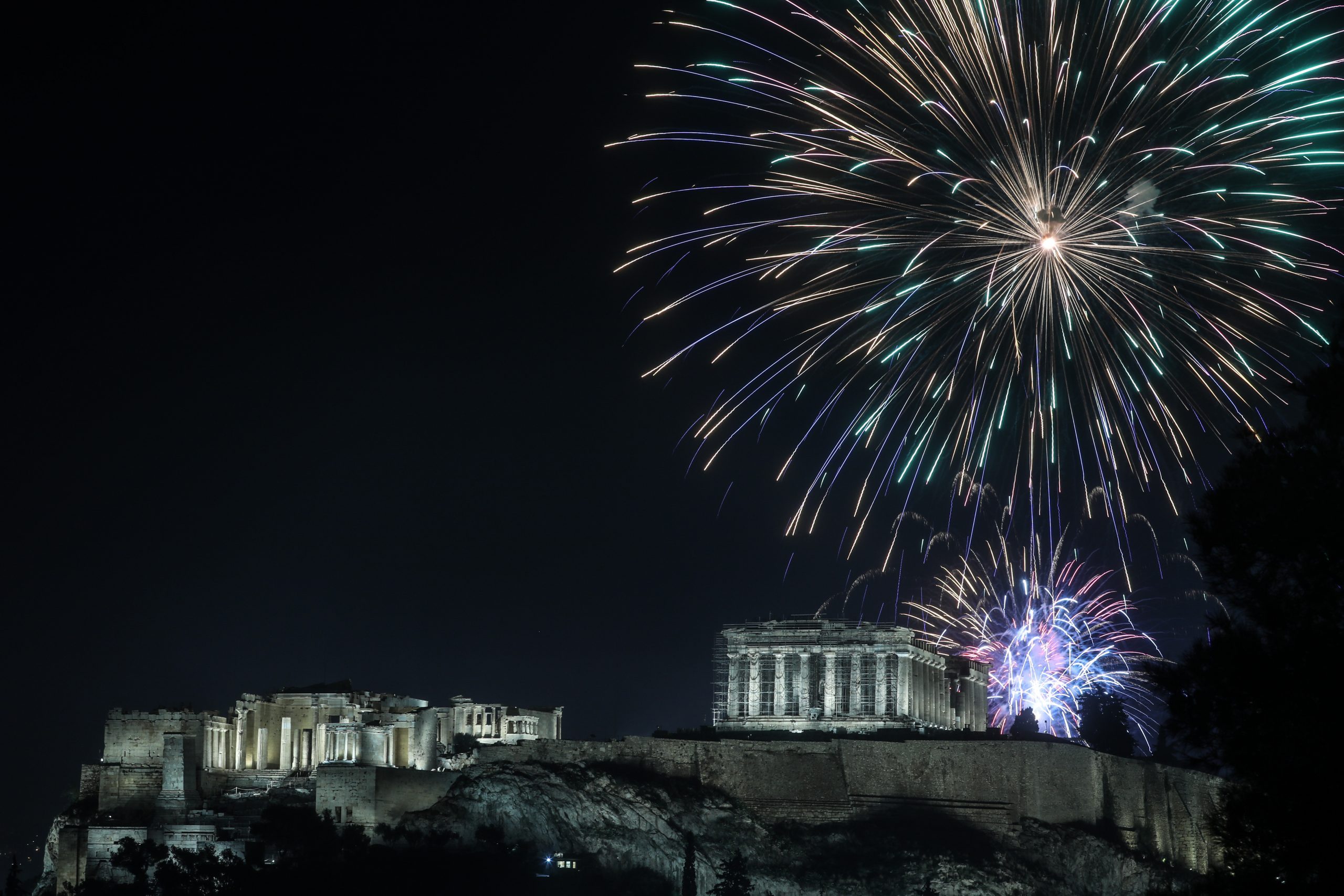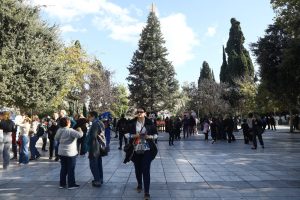It’s official. Santa has come to —and left —town, carols have been sung, pheasants have been feasted on. We’re resetting the calendar and people are ready to make their New Year’s resolutions and bid adieu to 2024 with a festive bash.
On New Year’s Eve, friends and family in the city gather to eat, drink and party until the last few minutes remain until the grand moment. When that moment comes, the crowd stands still, the music is turned down, the lights go off and the countdown begins… 3, 2, 1… The room is lit up once again and people cheer and embrace each other, sharing best wishes (and perhaps a kiss!) for the New Year, while a thunderous wave of fireworks engulfs the sky. Now that’s what I call an entrance!
Although this excitement and is shared across Greece, different regions have their own unique (and sometimes strange) traditions to usher in the New Year.
Vasilopita – an annual indulgence
Starting with the classics, New Year’s is the time to cut the annual vasilopita, a cake dusted with powdered sugar on which the year being welcomed is outlined with cocoa or cinnamon. A coin —called a “flouri” —is added to the batter before baking and whosever piece it turns up in is hailed as the “lucky one” for the New Year. Although using a bread or cake to hide the penny in is most common, variations appear across the country. In Xanthi in northern Greece, for example, instead of a cake, locals place the coin in a leek pie with minced meat and cumin. Similarly, in central Greece, the cities of Trikala and Karditsa bake a unique vasilopita decorated with intricate designs featuring scissors, flowers and crosses. The women, who traditionally bake the pie, place symbolic items including a coin, a plum twig, a grain of wheat, and a few strands of cow hair in the pie, to represent vitality, prosperity, and agricultural abundance.
Pomegranate pounding
Next on the list is the practice of smashing a pomegranate at one’s front door when the clock strikes twelve. Originating in the Peloponnese, this tradition has become quite common throughout Greece. According to lore, pomegranates symbolize abundance, fertility, and good fortune for the household. During the holidays, those true to the practice hang pomegranates on the main door of the house from Christmas until New Year’s Day, when the time comes for the fruit to be hurled against the entrance. An alternative practice involves taking the pomegranate to church, blessing it, and smashing it upon returning home. Some say the more the seeds that spread across the floor, the more good luck the household will enjoy, while if pomegranate juice falls on someone, they’re in for a very lucky year indeed.
Me to deksi! (With the right foot!)
Another classic tradition quite common around Greece is known as podariko (pod- “foot”) or “first footing”, where the family exits the house when the clock strikes twelve and a designated person re-enters the house, emphatically stepping in with their right foot, which symbolizes good fortune for the individual and the household.
A village-wide festivity

From December 25 to January 5 in western Macedonia, festivities fill village streets with dancers, actors, and musicians celebrating the Momoeria. Central to the custom are 30 male dancers dressed as priests of Momos (the god of laughter and satire), or commanders of Alexander the Great. Wearing traditional battle attire or animal costumes, they perform choreographed dances to appease nature and ensure the villagers’ prosperity.
New Year nuptials
Florina in northwestern Macedonia celebrates the vibrant tradition of Babaria. On New Year’s Day, groups of teenagers dressed in elaborate costumes take to the streets. Each group includes characters like a groom, a bride, grandparents, a hunchback, and sometimes even a doctor or priest. They perform a traditional slow dance from house to house, accompanied by bagpipes and tambourines.
A city ablaze
The northern Greek town of Kavala sees boys who are about to serve their conscription carrying pieces of wood to the city’s main square on New Year’s Eve, where they will light a bonfire come evening and sing carols. As soon as the clock strikes twelve, the whole town joins in with food, alcohol, and sweets. The youngest member of each family brings a stone into the house, to symbolize a solid foundation for the year ahead.
A “whiff” of the New Year
On New Year’s Eve, Ionian islanders take to the streets with bottles of perfume, spraying each other and singing wishes for the year to come.
Avian Omens
In the Cyclades, locals touch a piece of iron to their face after washing on New Year’s morning to symbolize good health and strength in the months ahead. They also believe that a dove appearing outside the house is a good sign, while seeing a crow is a bad omen.
Make a wish!
On the island of Thasos, family and friends sit around the fireplace, shovel some embers out of the fireplace and throw olive leaves onto them while making a silent wish. Whosever’s leaf shrivels the most will see their dream come true in the year ahead.
Shhhh!
New Year’s Eve on Mytilene sees groups from all over the city heading for a small church on the northern side of the town. The fountains of the church flow with water all day and the locals use it to wash their faces with. They then pour some of the holy water into a pot along with an olive branch, and head home for the “first footing” ritual. But for the house to be blessed, the “first footer” must remain silent all the way home!
Onions are the new mistletoe
On Crete, locals snub mistletoe wreaths on the front door for bouquets of… wild onions. Known as scilla matirima, these onions continue to flower even after they’re uprooted and grow new leaves. In a tradition that goes back to the 6th century BC, Cretans consider this rare quality a good omen and hang the onions in their homes on New Year’s Day. Evidently, they don’t mind that the onions are actually poisonous and can cause a skin rash!



